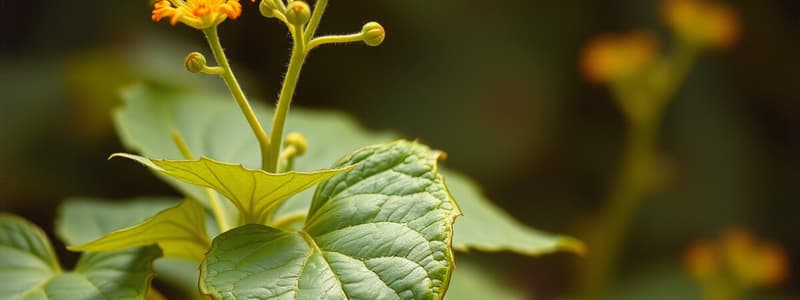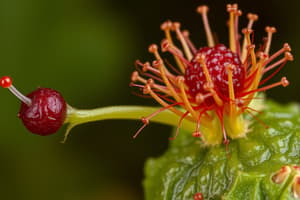Podcast
Questions and Answers
What role do plants often play in their interactions with microorganisms?
What role do plants often play in their interactions with microorganisms?
- They act solely as a nutrient source.
- They are indifferent to microbial interactions.
- They serve as sheltered habitats. (correct)
- They always suppress microbial growth.
Which of the following is a benefit to plants from microbial interactions?
Which of the following is a benefit to plants from microbial interactions?
- They use up the nutrients available to plants.
- They can enhance resistance to biotic stress. (correct)
- Microbial interactions are always harmful.
- Microbes only cause plant diseases.
What is a challenge researchers face when studying plant–microbe interactions?
What is a challenge researchers face when studying plant–microbe interactions?
- Disentangling complex multidimensional interactions. (correct)
- Identifying beneficial microbes is straightforward.
- Microbiomes are not diverse at all.
- There are no negative interactions to study.
What can plants release to support their associated microbes?
What can plants release to support their associated microbes?
What do researchers primarily focus on in negative plant–microbe interactions?
What do researchers primarily focus on in negative plant–microbe interactions?
What aspect of plant–microbe interactions is highlighted in the research discussed?
What aspect of plant–microbe interactions is highlighted in the research discussed?
How do most researchers approach the study of plant–microbe interactions?
How do most researchers approach the study of plant–microbe interactions?
Where are microorganisms found in relation to plants?
Where are microorganisms found in relation to plants?
What is one of the key components of a microbial community associated with plants?
What is one of the key components of a microbial community associated with plants?
How does ongoing research impact the understanding of plant–microbe interactions?
How does ongoing research impact the understanding of plant–microbe interactions?
What is a key characteristic of Streptomyces species that aids in plant growth?
What is a key characteristic of Streptomyces species that aids in plant growth?
Which benefit do plant growth-promoting bacteria provide in terms of environmental cleanup?
Which benefit do plant growth-promoting bacteria provide in terms of environmental cleanup?
What makes Bacillus amyloliquefaciens GB03 a valuable bacterium for perennial ryegrass?
What makes Bacillus amyloliquefaciens GB03 a valuable bacterium for perennial ryegrass?
What type of mycorrhizal fungus is associated with promoting cotton growth?
What type of mycorrhizal fungus is associated with promoting cotton growth?
Which feature of Streptomyces enhances their competitiveness in soil?
Which feature of Streptomyces enhances their competitiveness in soil?
What is the primary role of lytic enzymes produced by Streptomyces species?
What is the primary role of lytic enzymes produced by Streptomyces species?
How do certain plant growth-promoting bacteria affect the uptake of cadmium in plants?
How do certain plant growth-promoting bacteria affect the uptake of cadmium in plants?
Which abiotic stress factors can plant growth-promoting bacteria help alleviate in plants?
Which abiotic stress factors can plant growth-promoting bacteria help alleviate in plants?
What mechanism was proposed for the decreased colonization of Verticillium dahliae by cotton plants?
What mechanism was proposed for the decreased colonization of Verticillium dahliae by cotton plants?
What can be a potential outcome of applying plant growth-promoting bacteria in agriculture?
What can be a potential outcome of applying plant growth-promoting bacteria in agriculture?
Flashcards are hidden until you start studying
Study Notes
Plant-Microbe Interactions
- Plants engage with microorganisms throughout their lifecycle, often benefiting from these associations.
- Microorganisms colonize various plant regions, including apoplastic spaces, surfaces, and the rhizosoil.
- Plants provide habitats and nutrients to microbes while attracting them through the release of specific compounds.
Microbial Benefits to Plants
- Microbial interactions can enhance plant growth, resilience against stress, and defense against pathogenic microbes.
- The complexity of these interactions highlights the extensive microbial diversity associated with different plant parts.
Focus of Research
- Research on plant-microbe interactions explores both beneficial and detrimental effects.
- Negative interactions are studied to understand disease establishment, targeting microbial and plant factors involved.
Positive Plant-Microbe Interactions
-
Streptomyces Species:
- Filamentous bacteria that colonize soil and plant surfaces, producing antibiotics and volatile compounds.
- Act as biocontrol agents, antagonizing various plant pathogens and enhancing plant growth.
- Ability to produce lytic enzymes aids in nutrient availability for plants and survival under adverse conditions.
-
Phytoremediation:
- Plant growth-promoting bacteria, like those from metal-contaminated soils, enhance plants' abilities to tolerate and uptake heavy metals such as cadmium and zinc.
- Example: Helianthus tuberosus showed improved growth and stress tolerance when treated with these bacteria.
-
Drought and Salt Tolerance:
- Beneficial bacteria can significantly improve drought resistance in perennial ryegrass when used with water-retaining agents.
- Research isolates identify bacterial traits that contribute to optimally enhancing plant stress tolerance.
Mycorrhizal Fungi
- Rhizophagus irregularis CD1:
- Enhances growth and disease resistance in cotton against Verticillium wilt.
- Best-performing cotton variety showed increased growth and reduced pathogen colonization, likely through direct inhibition or induced resistance mechanisms.
Implications for Future Studies
- Understanding plant-microbe systems is crucial for enhancing plant fitness amid worsening climate conditions.
- Increased knowledge can aid in developing sustainable practices for agriculture and environmental remediation.
Studying That Suits You
Use AI to generate personalized quizzes and flashcards to suit your learning preferences.




